Winter getaways: Warm up in Basque country
Take a sunny winter getaway in Spain and you can put away those winter woollies!
Words & Pictures by Sue Nicholson
About 20% of people living in the Basque Country speak what is called the Basque language, but it’s spoken by an astonishing 80% of under 22s. The growth of Basque culture and prosperity since the Franco era is astonishing; this is what sets the region apart and the reason for our visit.
The Basques are a proud people, who want their own identity, but also want to be part of the wider world. You hear Basque being spoken everywhere and the best-selling newspapers are in Basque, too.
Green Spain
Our journey started on the MV Cap Finistère from Portsmouth to Bilbao; the crossing felt like a holiday in itself. We took advantage of a free Spanish lesson on board, the Basque language being too difficult for us. The first thing we noticed when we left the port, about 13 miles from Bilbao, was the lush countryside. This is ‘Green Spain’.
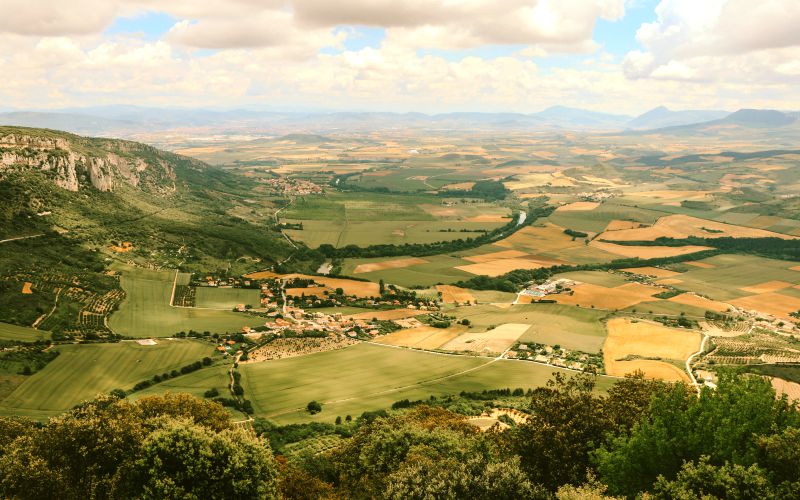
Our first site was in the delightful seaside town of Gorliz. The location was perfect; a bus stop outside, the town a five-minute walk away and just a stroll through a huge picnic area to a fantastic beach.
Reception staff were helpful, supplying us with a map and details of how to reach Bilbao.
We purchased a Barik Card €3 (£2.59) and loaded it with €30 (£25.88). This card is like London’s Oyster card and is used on all forms of the area’s transport, including the funicular and transporter bridge. Public transport is cheap, frequent and runs at weekends and holidays.
Into Bilbao
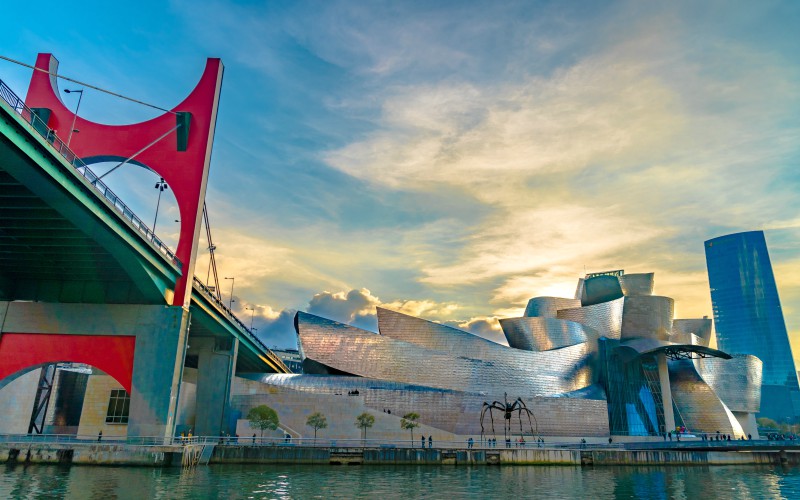
The tourist information office, our first stop, is right next to the Guggenheim Museum. This museum certainly lived up to its reputation, especially as Jeff Koons’ Puppy — a steel construction covered with over 40,000 bedding plants — sits on guard at the entrance.
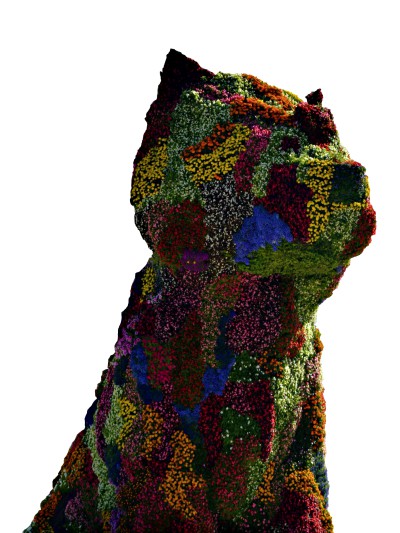 Originally a temporary exhibit, the locals loved Puppy so much it’s become permanent. Pictures don’t do it justice as you can’t smell the gorgeous flowers.
Originally a temporary exhibit, the locals loved Puppy so much it’s become permanent. Pictures don’t do it justice as you can’t smell the gorgeous flowers.
We were actually much more impressed with the museum building itself than the exhibits but, hey, that’s art for you! We had a fantastic lunch in the bistro, which we’d luckily pre-booked before leaving England.
Instantly impressed by Bilbao, we were keen to explore further. We took the Funicular de Artxanda to see the city from above, then strolled across the Zubizuri pedestrian bridge listening to the jazz-playing buskers.
From the riverbank you can cruise along the River Nervión with ‘Bilboats’, but these seemed to be fully booked. Ready for lunch, we decided to visit La Granja, in a lovely Art Deco building.
Pintxos are like tapas but, in our view, far better; they are little works of art. They don’t come free, but the bar was loaded with a huge selection of them. We could simply point to the pintxos that we wanted. We enjoyed four delicious pintxos and a couple of glasses of wine each for under €20 (£17.25).
Watching the locals, we realised it isn’t considered good manners to leave a used napkin on the bar. Sometimes, bars have little bins; at others, napkins are just dropped on the floor.
A local told us that if you walk into a pintxo bar and it’s crowded, don’t turn away. “You must attack like this…”, he said, proceeding to force his way to the bar. Nobody seemed to mind!
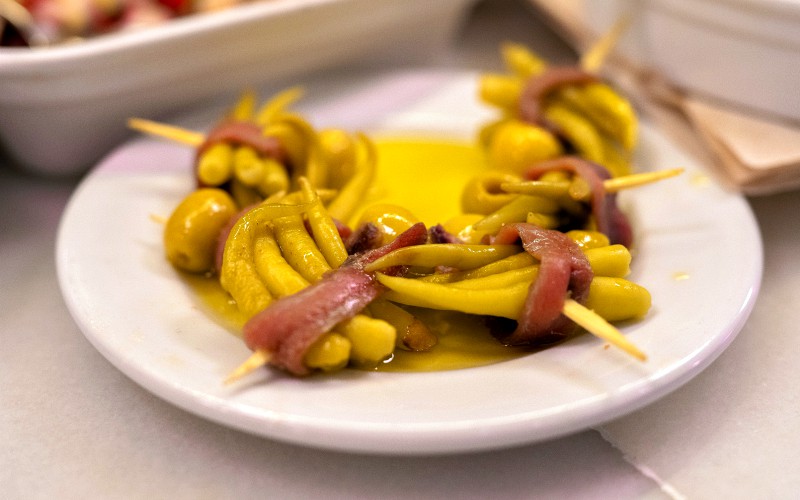
Culture tour
After lunch, we set off for the old town (Casco Viejo) to visit the beautiful Arriaga Theatre, cool and opulent inside. Casco Viejo is pedestrianised, with narrow streets. It is easy to walk around, with some lovely buildings and shops. Basque flags can be seen everywhere.
We particularly wanted to visit the fresh food market at Ribera. This is another lovely Art Deco building right on the river, with a cornucopia of fresh fish, hams and cheeses. We bought the local Idiazabál cheese, made with sheep’ milk.
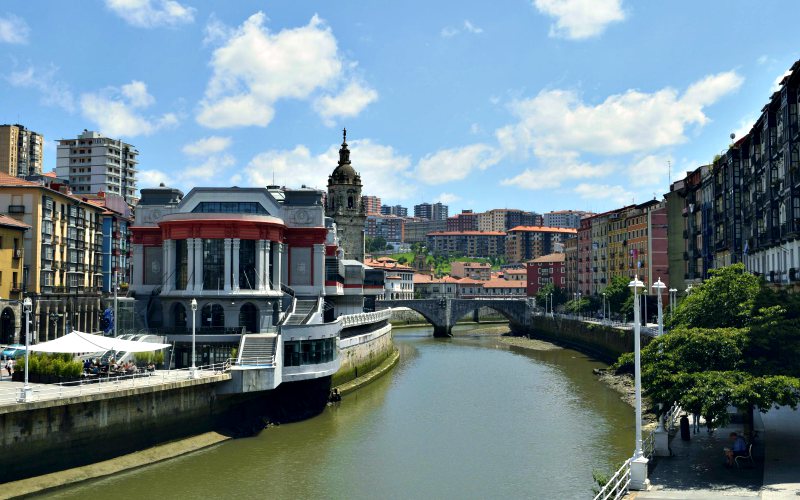
A tram took us to the Museo de Bellas Artes, with its interesting combination of sculptures, paintings by Gauguin and El Greco and an exhibition of 1950s French fashion. A sculpture by the popular Eduardo Chillida sits outside the museum.
There is a big difference between Bilbao’s old town, with its compact, narrow, pedestrianised streets and the new, with far more generous open spaces and parks. It’s lovely to have that contrast.
We were never far from a Metro station, and they were easy to find — we just had to look for the curved glass entrance structure called ‘Fosteritos’, named after the architect, Norman Foster.
Plaza Nueva is a neoclassical arcaded square, lined with pavement cafés — serving pintxos, of course! It is also the venue for the Sunday plant, animal and antiques market.
We visited two more museums: The National Archaeological Museum (free) and the Vasco museum. We were loaned a guidebook in English at the archaeological museum as information is in Spanish and Basque. The most famous exhibit at the Vasco is the Mikeldi Idol, a wild boar carved from stone.
Picasso and Guernica
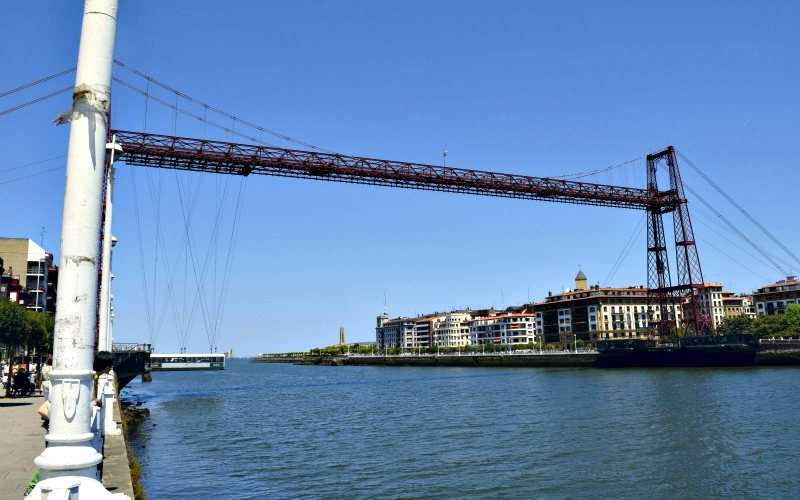
Having read about the Puente Colgante, a transporter bridge on the Nervión between Portugalete and Areeta Metro stations, we were keen to visit. This is the oldest transporter bridge in the world and you can whizz across in the gondola or take a walk 50 metres (164ft) up across the top of the bridge, from where the views across the river and Nervión estuary are incredible.
We wanted to visit Gernika, (aka Guernica) by bus. Gernika is famous because, in 1937, during the Spanish Civil War, German aircraft destroyed most of the town and killed much of the population with saturation bombing. The excellent Peace Museum gives moving accounts and details of the devastating effects.
Picasso was so moved by the destruction that, in the same year, he painted ‘Guernica’, a copy of which we saw in the town.
Gernika is also the home of the Assembly House where the highest governing body in the Basque Country sits. This is a must-see as it’s beautiful and has an amazing glass ceiling, representing a meeting under an oak tree; the general assembly used to hold meetings under an oak tree.
Through the centuries, successions of oak trees have continued this tradition and the original petrified oak is still there to see.
We also visited the Euskal Herria Museum, all about Basque culture. Santa Maria Church was closed, but we discovered why — it seems there is a shortage of priests in the area. In a neighbouring park are sculptures by Eduardo Chillida and the English sculptor, Henry Moore.
Classy San Sebastián
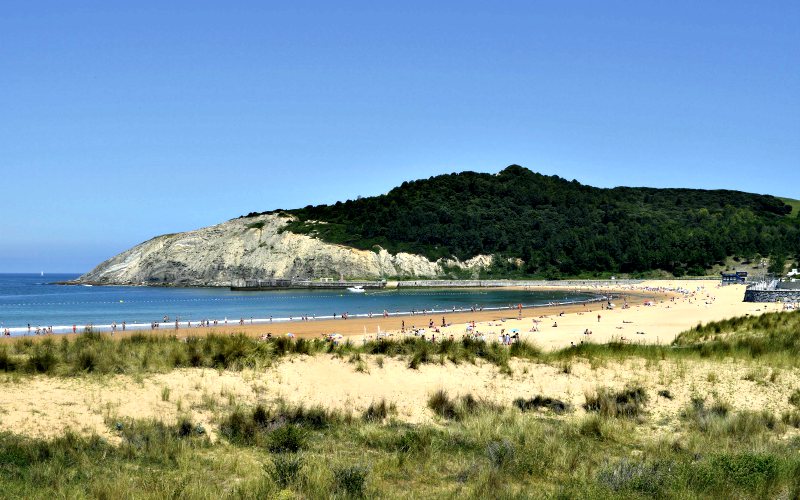
On our last day in the area we joined the locals on the sweeping beach in Gorliz before taking the motorway to San Sebastián, or Donostia, as it’s known to the locals. San Sebastián was the European City of Culture in 2016 and you can see why. The whole area smacks of class.
There are 16 Michelin stars spread around this city, which has a population equivalent to Luton. The pilgrims’ path, Camino de Santiago (Way of St James), runs through the centre.
On arrival at our pleasantly landscaped campsite, high in the Igueldo mountain range, we purchased a bus card from reception, which gave us each six journeys into the centre for just €16 (£13.80). The bus stop was right outside and it was a 25-minute ride into San Sebastián.
With so much to do and see, we started with the aquarium, home to over 5,000 fish. The main attraction is the transparent tunnel taking you close to a shark. There’s also a naval museum nearby.
Unlike Bilbao and Gernika, the churches in San Sebastián were open. San Vicente is the oldest building in the city and Santa Maria is of Baroque style from the eighteenth century. Above the main altar is a large painting representing the martyrdom of St Sebastián.
Foodies will love this place
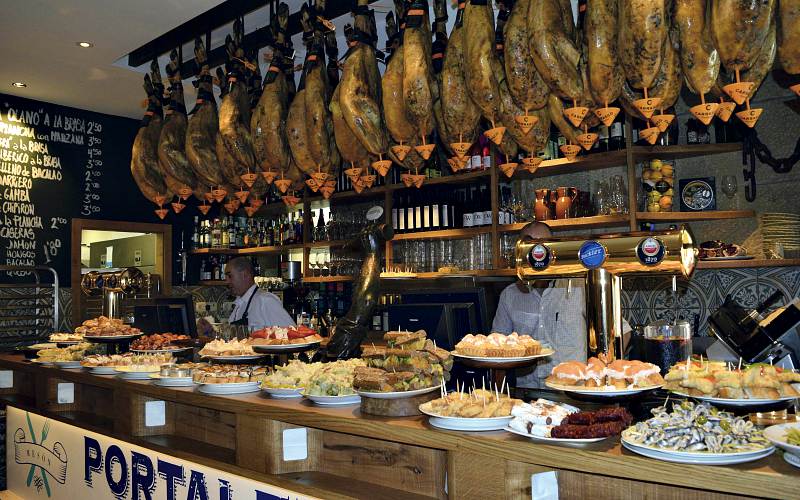
If you like your food, I would suggest heading for the old town. Having tasted pintxos in Bilbao, we booked a pintxo tour of San Sebastián via the tourist office.
Our tour started where the Michelin chefs buy their produce in La Bretxa Market, then it was on to three different bars for delicious pintxos chosen by the guide, including accompanying drinks.
We chose a glass of Txakoli, a local white wine poured from a height into a wide glass to aerate it. This wine is a great accompaniment to Idiazábal cheese or anchovies from Bermeo.
The tour was fun and the guide was coaching ‘volunteers’ to order drinks in the Basque language. By chance, we stopped outside a gentlemen’s club to which the men (only) invite their friends, cook for them and divide the cost. The locals take cooking and eating seriously.
Spotting us standing with the guide, some gentlemen insisted on us drinking two carafes of Txakoli with them. It was wonderful! The pintxos were simply the best and the guide reminded us to try another authentic Basque ‘gilda’ — a pintxo made with chilli pepper, olives and anchovies.
Santa Clara Island in the bay is reached by a short boat trip. High up on the island, with its small beach full of families, we got a great view back to the bay.
Funicular views
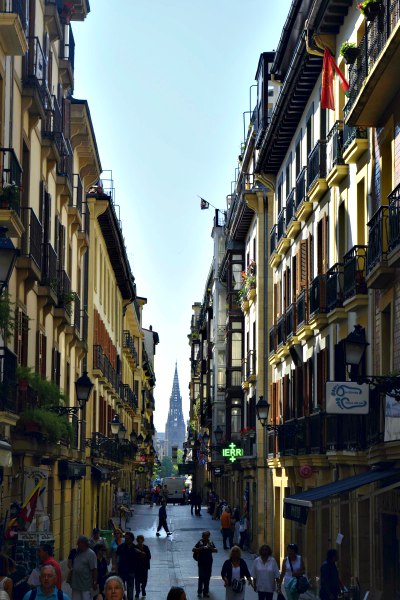 The following day we strolled along the entire bay, which took over an hour. There are actually three beaches in the area: Ondarreta, La Concha and the Zurriola across the Urumea river, popular with surfers.
The following day we strolled along the entire bay, which took over an hour. There are actually three beaches in the area: Ondarreta, La Concha and the Zurriola across the Urumea river, popular with surfers.
The views from the funicular were breathtaking. On the trip up we could sit with our backs to the hill to watch the city disappearing before us. At the summit is a small, old-fashioned funfair, and we could see the entire bay, including the island and Mount Urgull with its huge statue of Christ (Sagrado Corazón — Sacred Heart).
Near the bottom of the funicular is another San Sebastián landmark, a sculpture by Chillida, called El Peine del Viento (The Comb of the Wind). We found San Sebastián such an easy city to stroll around and the many cycle lanes can also take you to most parts of the city.
San Telmo Museum is in a lovely setting. Part of it is a church with beautiful cloisters and it’s an architectural jewel. We particularly wanted to see this museum as there was a retrospective of the Italian film maker, Pier Paolo Pasolini. We love film and cinema and it was interesting to see the original handwritten screenplays for films like La Dolce Vita.
Walking into the Plaza de la Constitución (the old bull ring), we could see the original box numbers on the balconies from those bullfighting days; the balconies now converted to flats. Shady bars with comfy seats occupy some colonnades.
The next day we had booked lunch at La Perla, on La Concha. The meal was fantastic.
The Basque Country seemed so prosperous and Bilbao was brilliant and exciting. Gernika was truly moving and San Sebastián was simply gorgeous!
Where to eat
- San Sebastián is full of little bars and restaurants serving up pintxos — it's a little like tapas and you're encouraged to get stuck in!
- In Bilbao, you'll find there's plenty in the way of fine dining including Mina — a restaurant opposite the market at Ribera. The Guggenheim's bistro gets booked up so make a reservation.
- You'll find authentic, traditional cuisine in Gorliz and a handful of small, family-run restaurants. Okela is a popular choice for locals and holidaymakers and has won awards for its mushroom dishes!
- While most people might not visit Gernika (Guernica) for gastronomy, Restaurante Zimela is a foodie delight.
Useful websites
Where to stay
Prices couple, electric hook-up, per night
Camping Arrien Gorliz
Uresarantze Bidea 15 Bis,
48630 Biscay, Spain
T 0034 946 771911
W campinggorliz.com
Open 1 March to 31 October
Price from €26.84 (£23.13)
Camping Igueldo
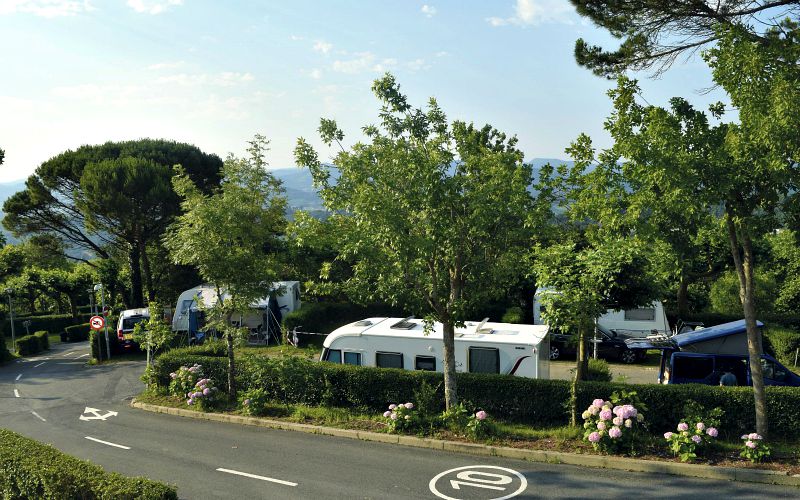
Paseo Padre Orkolaga 69,
20008 San Sebastián
T 0034 943 214502
W campingigueldo.net
Open All year
Price from €24.50 (£21.12)








Recent Updates
Caravanning with dogs: all you need to know
Caravan holidays with dogs are a joy for lots of reasons. Firstly, many people choose to buy a caravan specifically because they have a dog – or more ...
How to set up a caravan: all you need to know
Setting up your caravan on a campsite pitch is just a sequence of actions. They’re second nature to ...
Caravan showers: all you need to know
In this guide, we’ll discuss the different types of showers, how they work, and how to fit an external shower ...
Caravan towing: all you need to know
Towing a caravan may seem daunting initially, but a few simple tips can make the journey enjoyable and ...
All you need to know about towbars & towballs
Flange, detachable, swan neck, retractable – towbar technology choice is bewildering. Don’t worry. We’ll ...
Caravan WiFi: everything you need to know
Caravan holidays are the ultimate way of getting away from it all, although we sometimes need a link to the ...
Caravan insurance: all you need to know
Navigating the world of caravan insurance can feel like a daunting task. Fear not, as this comprehensive ...
Buying a caravan: what you need to know
Let us guide you through some of the complicated things to think about when first looking at buying a ...
Caravan awnings: a buyers' guide
Caravan awnings are a fantastic addition to any caravan as they are one of the simplest, quickest and most ...
Caravan electrics: avoid tripping out
All caravan owners have overloaded their mains supply at some time. Here’s how to master caravan electrics ...
Other Articles
Caravan heating systems: a quick guide to caravanning warmth
When winter is here, you’ll be glad of a decent caravan heating system if you’re out touring. Here’s how the different systems work ...
Caravan damp: a complete guide
There's little more guaranteed to strike fear into the heart of a caravan owner than the word 'damp'. But if ...
Caravan jockey wheels: the definitive guide
A well-functioning caravan jockey wheel can make all the difference to manoeuvring away from the towcar, ...
Caravan cooking recipes
Caravan cookery inspirational ideas. No need to stress out in the kitchen with these quick and easy ...
Caravan bike racks: a complete guide
Exploring the beautiful surroundings while on a caravan trip is undeniably one of the greatest joys of the ...
Caravan solar panels: all you need to know
Whether you dream of roaming off-grid or just fancy reducing your carbon footprint, fitting solar panels to ...
The ultimate guide to caravan layouts
Choosing the right layout or floorplan of your caravan is an all-important part of the buying process – find ...
A guide to seasonal caravan pitches
Our in-depth guide to finding and securing seasonal caravan pitches on your favourite campsite ...
Caravan weights and payloads: a quick guide
The terminology of caravan weight – MIRO, MTPLM, noseweight, kerbweight, payload, weight plate upgrade – is ...
The ultimate guide to caravan motor movers
Caravan motor movers: everything you need to know about remote control caravan manoeuvring ...